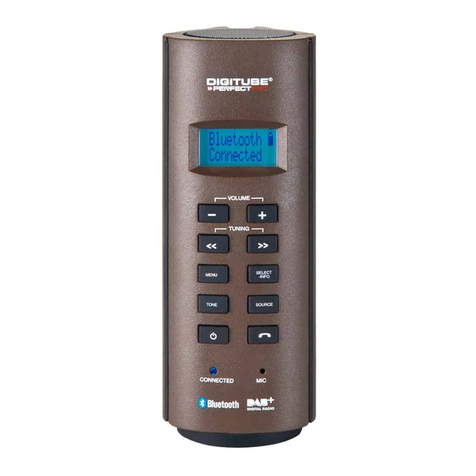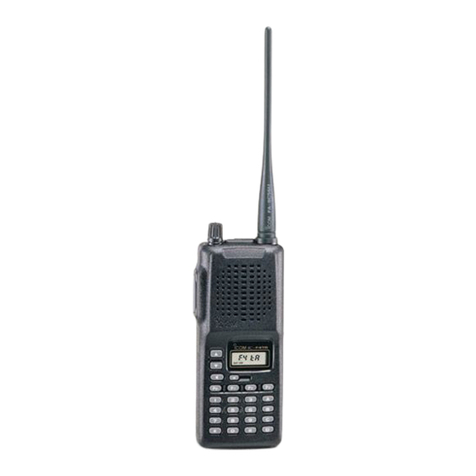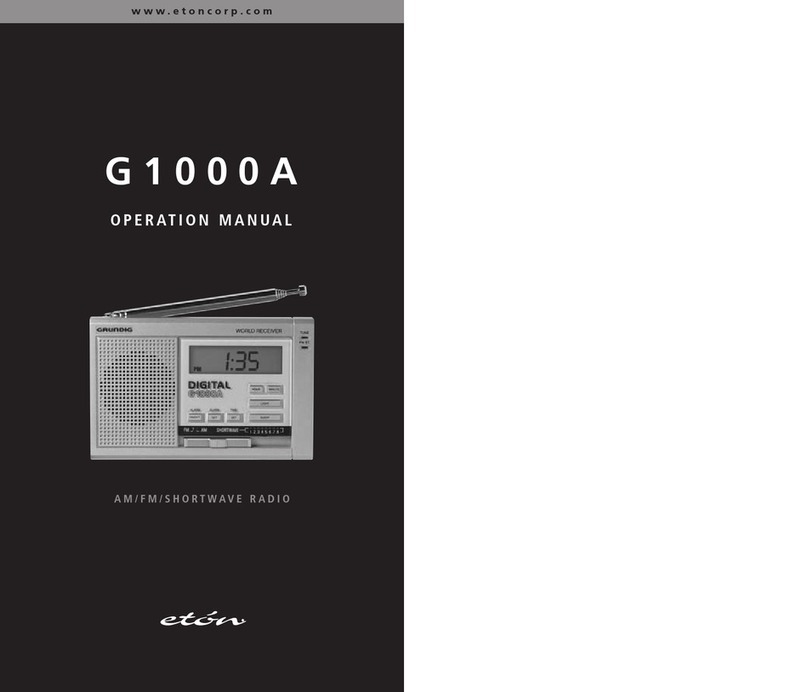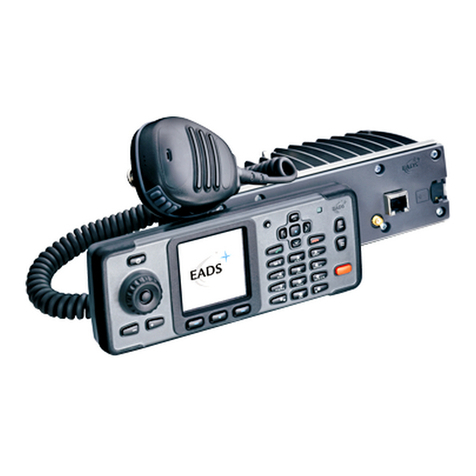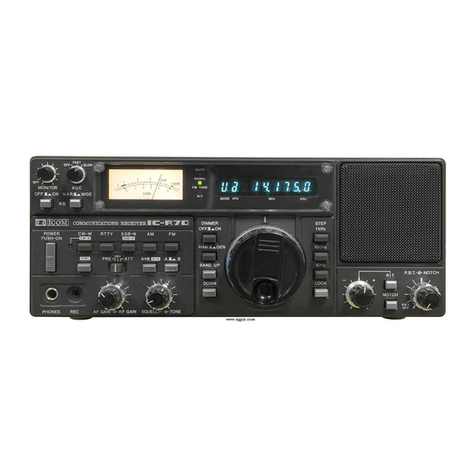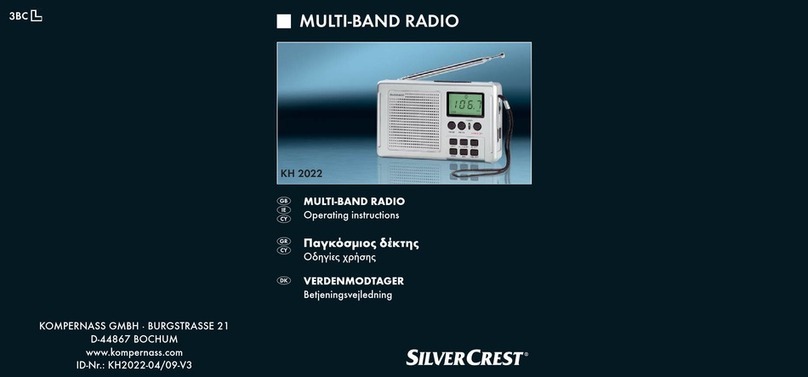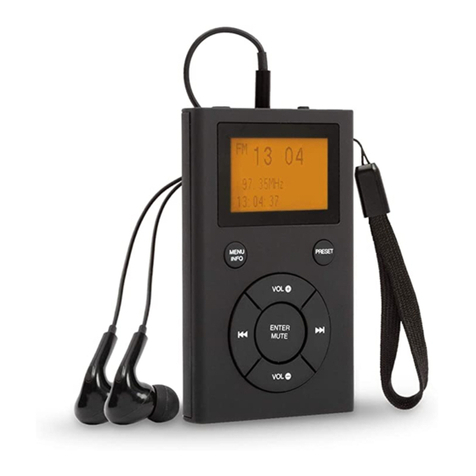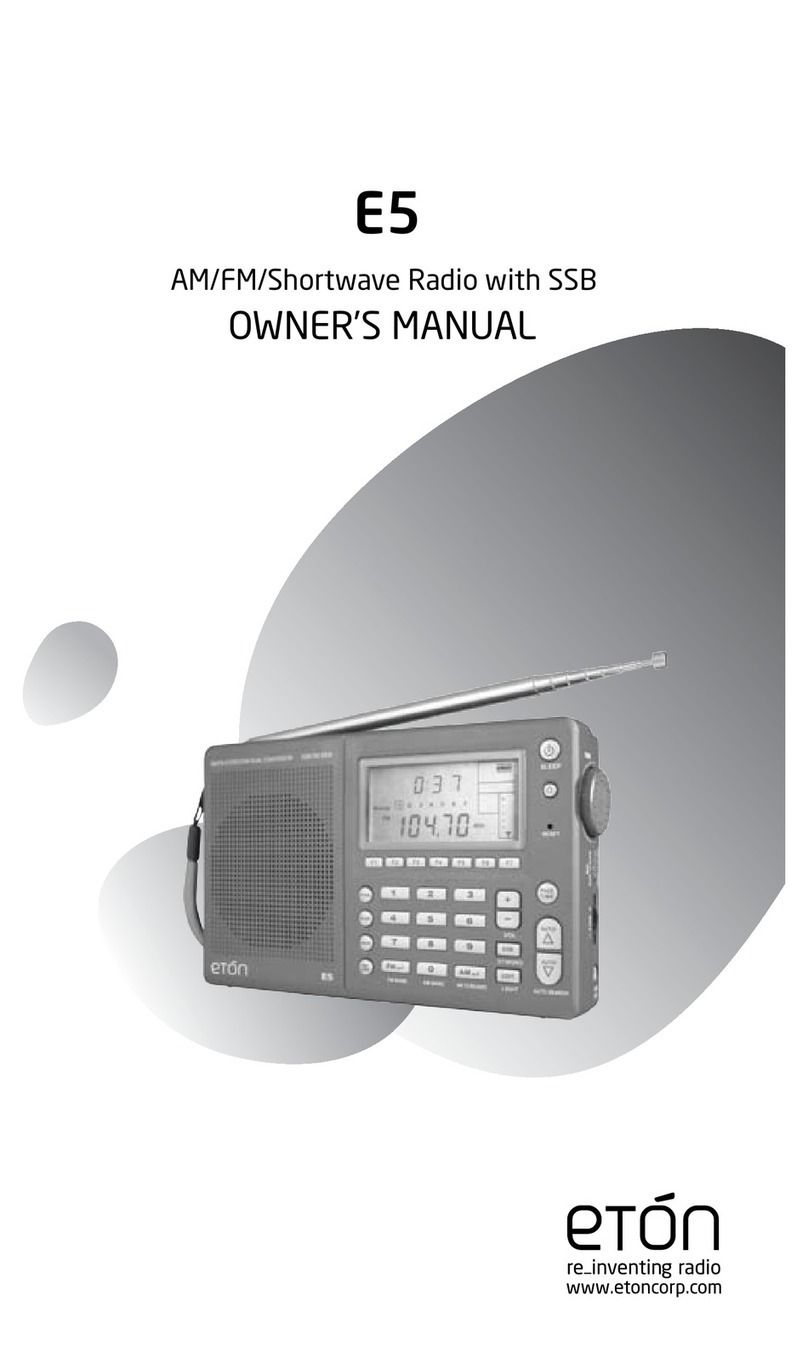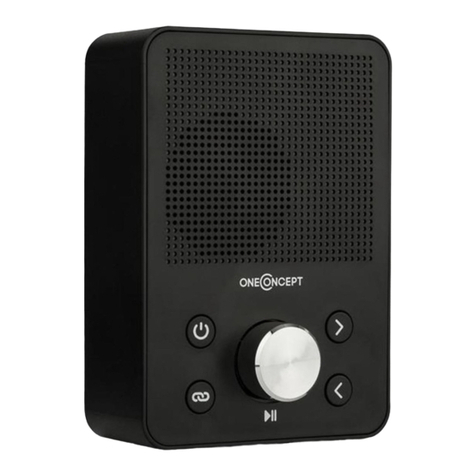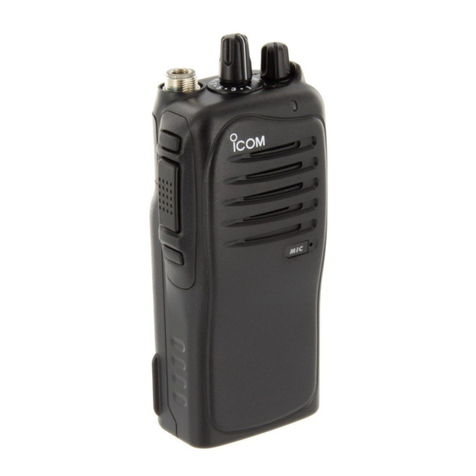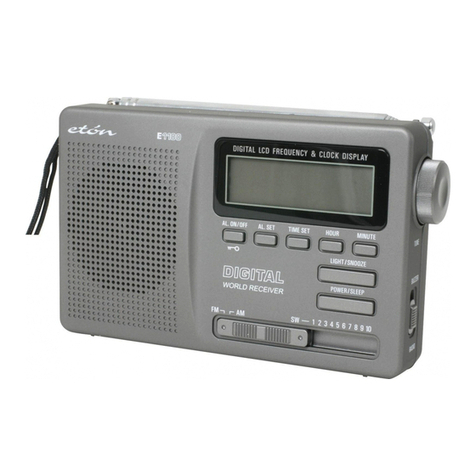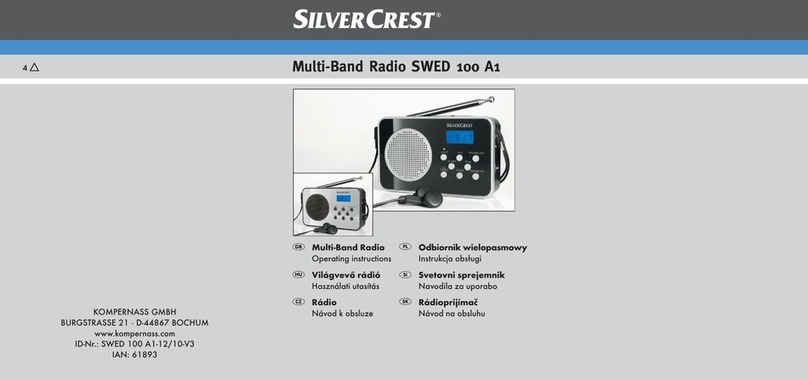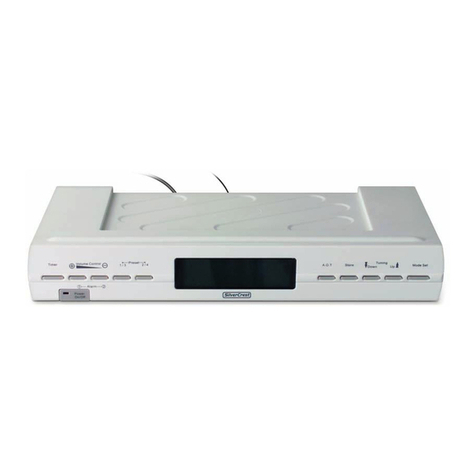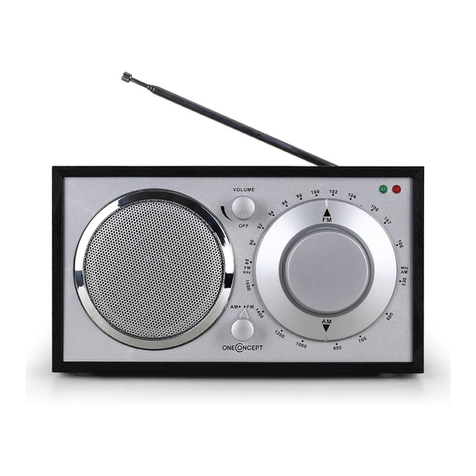Cardin Elettronica S435 Series User manual

S435 RP435RN
03-04-2002
ZVL328.02
CARDIN ELETTRONICA spa
Via Raffaello, 36- 31020 San Vendemiano (TV) Italy
Tel: +39/0438.404011-401818
Fax: +39/0438.401831
Http: www.cardin.it
Descrizione
Il sistema di radiocomando S435 per tapparelle è composto da uno o più trasmettitori e da uno o più
ricevitori che saranno combinati in relazione alle esigenze specifiche d'impianto.
La serie S435 per tapparelle usa un sistema di codifica ad alta affidabilità garantita dall'uso di codici
dinamici. Ad ogni trasmissione il codice cambia in base ad un algoritmo che solo il ricevitore è in grado
di riconoscere stabilendo se la trasmissione è corretta rispetto al codice originale; la generazione del
codice di partenza avviene sul trasmettitore in modo random per ogni tasto su 2
36
combinazioni. Il
codice generato viene memorizzato via radio sul ricevitore. Nel ricevitore si possono memorizzare
fino a 24 codici diversi, che vengono mantenuti in memoria anche in assenza di corrente. Essendo
un sistema di codici dinamici ogni tasto di canale del trasmettitore è associato ad un codice e viene
gestito singolarmente dal ricevitore.
Importante: questa è un 'apparecchiatura che si avvale di un sistema di codifica ad alta sicurezza
quindi lo smarrimento di uno o più radiocomandi comporta l'obbligo di riprogrammare i codici
del sistema, per mantenerne l'inviolabilità.
Possibilità d'impiego
Il radioprogrammatore permette il comando a distanza di un motore monofase 230Vac, 50-60Hz,
400W e trova il suo miglior utilizzo nel comando di tapparelle.
Il radioprogrammatore dispone di un ingresso "TD" al quale può essere collegato un pulsante di
comando esterno con funzione dinamica in sequenza apre/stop/chiude/stop; questo consente di
comandare singolarmente un motore (tende). Per l'azionamento in comune di più motori si potrà
utilizzare il radiocomando avendo cura di memorizzare gli stessi canali su più radioprogrammatori.
Versioni trasmettitori
TRS435400 Trasmettitori tascabili 4 tasti
TRS43540M Pulsantiera radio per fissaggio a muro 4 tasti
Versioni ricevitori
RP435RNN0 Radioprogrammatore RP435 senza anemometro
RP435RNA0 Radioprogrammatore RP435 con anemometro
Installazione ricevitore-antenna
Portata minima e massima dei radiocomandi:
Per portata si intende la distanza utile di funzionamento fra trasmettitore e ricevitore con antenna
installata, e misurata in spazio libero. La portata è quindi strettamente legata alle caratteristiche
tecniche del sistema (potenza e sensibilità) e varia in base alle caratteristiche del luogo di postazione.
Per ottenere il funzionamento ottimale del radiocomando è bene scegliere con attenzione i punti
d'installazione del ricevitore e dell'antenna.
Non è consigliabile l'installazione di due ricevitori che non rispettino una distanza minima di 1,5m tra
loro ed è buona norma posizionare il ricevitore a debita distanza da reti di sistemi computerizzati, da
impianti d'allarme e da altre fonti di possibile disturbo.
(Sistemazioni anomale potrebbero compromettere in parte il funzionamento)
Antenna
L'installazione dell'antenna è fondamentale; collegata al ricevitore rappresenta il punto di ricezione del
radiocomando. I ricevitori sono dotati di antenna propria, consistente in uno spezzone di filo rigido,
lungo170mm.Inalternativa è possibile collegarel'antennaaccordataANS400dacollegarealricevitore
mediante cavetto coassiale RG58 (impedenza 50Ω) di lunghezza max. 15m; l'antenna va posizionata
all'esterno nel punto più elevato e visibile, lontano da strutture metalliche.
RICEVITORE
Installazione
In base alla tipologia e alle caratteristiche d’impianto individuare il punto di posa dell’apparecchiatura.
L’apparecchiatura dovrà essere collocata:
- in ambiente interno;
- al riparo da urti e manomissioni;
- in una posizione facilmente raggiungibile dal tecnico, per interventi di manutenzione.
• Svitareleduevitidissaggioealzareilcoperchio.
• Tracciare(conl’ausiliodellascatola)iduepuntidissaggioessareilcontenitoreutilizzandodue
viti autofilettanti M4 e relativi tasselli.
• Togliereledueprotezioniinplasticasull’ingressodeicavi.
Collegamento elettrico (fig. 9)
• Primadieseguireilcollegamentoelettricoaccertarsiche:
- latensioneelafrequenzariportate sulla targhettacaratteristichecorrispondano a quelledell'impianto
di alimentazione;
- un interruttore onnipolare con apertura tra i contatti di almeno 3mm sia inserito a monte dell'appa-
recchiatura;
- i cavi di collegamento siano protetti da sollecitazioni meccaniche.
• L'apparecchiaturadeveesseremessaaterra,aquestoscopovièunmorsettocontrassegnatocon
il simbolo al quale deve essere collegato il filo di terra.
Generazione del codice utente nei trasmettitori (fig. 1-5)
•Per la pulsantiera radio con fissaggio a muro, una volta aperto il contenitore (vedi fig. 9), la procedura
di generazione codice è identica a quella del trasmettitore (il circuito è lo stesso).
1) Aprire il portello facendolo scorrere sulle slitte di fissaggio (fig.1).
2) Premere il pulsante "J1" (fig. 2)
3) Tenendo azionato "J1" premere il pulsante "CH" corrispondente al canale da memorizzare; led
"L1" comincia a lampeggiare (fig. 3)
4) Rilasciare il tasto canale "CH" il led continua a lampeggiare (fig.4).
5) Rilasciare "J1", il led si spegne ed il trasmettitore memorizza l’ultimo codice generato (fig.5).
6)Ripetereipunti2-3-4-5perglialtricanali.Senonvienegeneratouncodicelamemoriadeltrasmet-
titore può essere vuota perciò non è possibile il trasferimento del codice al ricevitore.
Gestione codici nel ricevitore (fig. 9)
Attenzione! Prima di procedere alla prima memorizzazione dei trasmettitori, ricordarsi di can-
cellare interamente la memoria.
Memorizzazione di un codice nel ricevitore
1) Premere il pulsante "P1" (fig. 9) e tenerlo premuto: il rice-
vitore emetterà una serie di "Bip" ad intervalli regolari.
2) Trasmettere il canale da memorizzare (fig. 6).
3) Il ricevitore emetterà una serie di "Bip" ad intervalli
più brevi indicando che il canale è stato memorizzato.
Rilasciare il pulsante "P1".
È possibile inserire un solo codice alla volta, per inserire
un successivo codice rilasciare il pulsante e ripetere i
punti 1,2,3.
Se il codice non viene memorizzato
- il codice trasmesso esiste già in memoria.
- sul trasmettitore non è stato generato il codice associato a quel canale.
- la memoria è completa (con 24 codici già memorizzati).
In questo caso è possibile inserire un nuovo codice solo cancellando un codice esistente o tramite
la cancellazione della memoria intera (vedi procedura di cancellazione).
Attenzione: quando la memoria è completamente occupata, il buzzer emette una segnalazione sonora
per circa 5 secondi; lo stesso avverrà ogni volta che il dispositivo viene riavviato.
Procedura di cancellazione di un codice nel ricevitore
1 Utilizzando un cacciavite premere due volte sul tappo in plastica azionando il pulsante "P1" e tenerlo
premuto. Il ricevitore emetterà una serie di "Bip" intermittenti.
2) Trasmettere il canale da cancellare (per almeno 5 s). Il ricevitore emetterà una serie di "Bip" ad
intervalli più brevi indicando che il canale è stato cancellato. Per cancellare un successivo codice
ripetere i punti 1 e 2 dopo aver rilasciato il pulsante
Per cancellare tutti i codici
1) Premere tre volte sul tappo in plastica azionando il pulsante "P1" e tenerlo premuto (per almeno 5
secondi). Il ricevitore emetterà una serie di "Bip" ravvicinati.
Anemometro (opzionale)
Conl'anemometroinstallatosipuò programmarelachiusura automatica incondizioni diventoforte.
Il dip-switch "D1" (fig. 9) ha quattro livelli di selezione: 20-35-42 e 50 km/ora. Con anemometro
attivo (situazione di vento) è inibita la funzione di radiocomando o "TD" via filo per 13 minuti.
Per effettuare la regolazione della sensibilità durante la fase d'installazione è possibile annullare
tale periodo di blocco togliendo e rimettendo l'alimentazione: in tal caso converrà disinserire
momentaneamente la richiusura automatica (Dip 1 "ON" fig. 9).
Selezioni Dip-switch D1 (solo con anemometro)
Dip 1 ON Disabilita la chiusura forzata all'accensione
Dip 2 ON Esclude la funzione anemometro
Dip 3 OFF
Dip 4 OFF
Dip 3 OFF
Dip 4 ON
Dip 3 ON
Dip 4 OFF
Dip 3 ON
Dip 4 ON
Richiusura forzata
Nella versione con anemometro, selezionando Dip 1 su "OFF" si abilita tale funzione, che consiste
nella chiusura forzata ad ogni riavvio del radioprogrammatore.
Nella versione senza anemometro tale funzione è sempre disabilitata
CARATTERISTICHE TECNICHE
Ricevitore
- alimentazione............................................................................................................230Vac, 50-60Hz
- canali memorizzabili .........................................................................................................................24
- combinazioni di codici........................................................................................................ 68 miliardi
- velocità vento (selezionabile).............................................................................. 20-35-42-50 km/ora
- temperatura di esercizio...............................................................................................-20°… + 60 °C
- fusibile...................................................................................................................F3,15A 250V (5x20)
Trasmettitore
- frequenza portante ...........................................................................................................433,92 MHz
- alimentazione..................................................................................................................... 12V ± 10%
- assorbimento............................................................................................................................. 40 mA
- temperatura d'esercizio.................................................................................................-10°… +55 °C
RADIOPROGRAMMATORE A CODICI DINAMICI PER TAPPARELLE
1234
ON
}Velocità vento 20 km/ora
} Velocità vento 35 km/ora
}Velocità vento 42 km/ora
}Velocità vento 50 km/ora
RADIO RENO
Bip…Bip…Bip
Programmazione Radio Reno
RXPR RENO
14-04-99
DM0415 Description :
Product Code :
Date :
Drawing number :
P . J.Heath
CARDIN ELETTRONICA S.p.A-31020SanVendemiano (TV) Italy - via Raffaello, 36 Tel: 0438/401818 Fax: 0438/401831
Draft :
All rights reserved. Unauthorised copying or use of the information contained in this document is punishable by law
ZVL328.02 / Mod: 16-07-2007
La serie S435 è conforme ai requisiti essenziali fissati dalla direttiva 99/05/CE e
ad esso sono state applicate le norme tecniche di riferimento.
Frequenza: 433.92 MHz per tutti i paesi
MODELLO DATA
CODICE SERIE

S435 RP435RN
03-04-2002
ZVL328.02
CARDIN ELETTRONICA spa
Via Raffaello, 36- 31020 San Vendemiano (TV) Italy
Tel: +39/0438.404011-401818
Fax: +39/0438.401831
Http: www.cardin.it
DIGITAL RADIO PROGRAMMER WITH DYNAMIC CODES FOR ROLLING SHUTTERS
Description
The S435 radio programming system for rolling shutters consists of one or more transmitters and one
or more receivers which can be combined to meet the specific needs of the system.
The S435 system for rolling shutters uses a highly reliable encoding system guaranteed by the use of
dynamic codes. The code is changed for each encoding transmission through the use of an encoding
algorithm which only the receiver is able to recognise and therefore decide whether or not the code
transmitted corresponds to the original code. The code is generated for each channel in the transmitter
using the random arbitrary method with 236 combinations. The generated code is memorised in the
receiver via radio. The receiver is able to memorise up to 24 different codes which are stored in a non
volatile memory and are maintained even during blackouts. As this is a system based on dynamic codes
each code is processed individually by the receiver.
Important: this is a device which uses a high security encoding system it follows therefore that
if you lose one or more transmitters you will have to reprogram the system codes in order to
maintain the inviolability of the system.
Use
The radio programmer allows the remote activation of a single phase 230Vac, 50-60Hz, 400W motor
and is best used in systems controlling automatic rolling shutters.
The radio programmer features a "TD" input (fig. 9) which can be used to connect an external control
buttonwithsequentialdynamicfunctions"Open-Stop-Close-Stop".Thisallowsyoutocontrolone
motor (sun blind) singularly. By memorising the same channel on more than one radio programmer a
transmitter may be used to control more than one motor contemporaneously.
Transmitter versions
TRS435400 Pocket transmitter 4 buttons
TRS43540M Wall mounted transmitter 4 buttons
Receiver versions
RP435RNN0 Radio programmer RP435 without anemometer
RP435RNA0 Radio programmer RP435 with anemometer
Receiver antenna installation
Minimum and maximum range of the radio controls.
‘Range’ is intended to mean the working distance, measured in free space, between the receiver and
the transmitter with the antenna installed. The range is therefore closely linked to the technical char-
acteristics of the system (power and sensibility) and varies according to the characteristics of the site
in which the system is located. It therefore follows that to obtain the best results from the radio control
the installation sites for the receiver and the antenna should be carefully chosen.
You are not advised to install 2 receivers at a distance of less than 1.5 m from each other and it is
also good practise to position the receiver away from computer systems, alarm systems and other
possible sources of disturbance.
(A bad choice of positioning could compromise the correct performance of the receiver).
Antenna
The installation of the antenna is fundamental, connected to the receiver it represents the reception
point for the radio control. The receiver is supplied with its own antenna which consists of a piece of
rigid wire 170 mm in length. In alternative it is possible to connect an ANS400 tuned antenna using a
coaxial cable RG58 (impedance 50Ω) with a maximum length of 15 m. The antenna should be positioned
out of doors in the highest possible point, visible and away from metal structures.
RECEIVER
Installation
Depending on the type of installation, work out the position in which the programmer will be situated
remembering that the site must be:
- an indoor installation;
- a position safe from accidental collision and tampering;
- in a position which the technician can easily reach.
• Removethetwoholdingscrewsandliftupthecover
• Usingthecontainerasatemplatemarkthefourpointsatwhichthefasteningholesaretobedrilled
and fasten down using four self-tapping M4 screws and relative rawlplugs.
• Removethetwoplasticcabledividers.
Electrical connection (fig. 9)
• Beforeconnectingthedevicetothemainsmakesurethat:
- the voltage and frequency rated on the data plate conform to those of the mains supply;
- an all pole circuit breaker which leaves at least 3 mm between the contacts has been installed
between the device and the mains;
- the wires are fastened down using a cable clamp.
• Theappliancemustbeearthed,tothisendusethebindingpostmarkedwiththesymbol which
can be found on the wiring box.
Generating the user code in the transmitters (fig. 1-5)
• Oncethecontainerhasbeenopened (g. 9) the programmingprocedurefor the wall mounted
transmitter is the same as for the hand held transmitter (the circuit is the same).
1) Open the access door (fig. 1)
2) Press the button "J1" (fig. 2)
3) While keeping button "J1" pressed down press the button "CH" corresponding to the required
channel which is to be memorised and Led "L1" will start to flash (fig. 3).
4) Release the channel button "CH" and the led will carry on flashing (fig. 4).
5) Release the button "J1", the led will turn off and the transmitter will memorise the last code which
was transmitted (fig. 5).
6) Repeat points 2-3-4-5 for any successive channels. If a code is not generated it could be due to the
fact that the memory is empty and it is therefore impossible to transfer the code to the receiver.
Generating the user code in the receiver (fig. 9)
Attention! Before memorising the transmitters for the first time remember to cancel the entire
memory content.
Memorising the user code in the receiver
1) Press the button "P1" (fig. 9) and keep it pressed down: the
receiver will emit a series of "Beeps" at regular intervals.
2) Transmit the channel which is to be memorised (fig.6).
3) The receiver will emit a series of "Beeps" at shorter intervals
indicating that the channel has been memorised. Release the
button "P1".
Only one code can be inserted at a time. To insert successive
codes repeat steps 1, 2 and 3.
If the code is not memorised
- The code may already exist in memory;
- You have not generated a channel code in the transmitter.
- The memory is full (24 codes already memorised).
If this is the case you can only insert a new code after you have first cancelled an existing one or
after wiping the entire memory (see memory cancelling procedure).
Attention: when the memory is full the buzzer will sound for about 5 seconds. This also happens each
time the receiver is reset.
Cancelling a code in the receiver
1) Using a small screwdriver and pressing lightly on the plastic cap, activate the button "P1" twice and
keep it pressed down. The receiver will emit a series of "Beeps" intermittently.
2) Transmit the channel which is to be memorised (for at least 5 seconds). The receiver will emit a series
of "Beeps" at shorter intervals indicating that the channel has been cancelled. To cancel successive
codes repeat steps 1 and 2 after having released the button.
To cancel all codes
1) Press lightly on the plastic cap three times to activate the hidden button "P1" and keep it pressed
down for at least five seconds. The receiver will emit a series of rapid "Beeps".
Anemometer (optional)
With an anemometer installed you may programming automatic closing in strong wind conditions.
The dip-switch "D1" (fig. 9) has four settings: 20-35-42 and 50 km/hour. When the anemometer
is active (strong wind conditions) control via the transmitter and the "TD" button will be excluded
for 13 minutes.
To calibrate the sensitivity level during installation you can override this block by switching the
power off and on again: however in this case you are advised to temporarily deactivate automatic
reclosing (Dip 1 "ON" fig. 9).
Dip-switch D1 settings (only with an anemometer)
Dip 1 ON Exclude forced closing on power on
Dip 2 ON Exclude the anemometer function
Dip 3 OFF
Dip 4 OFF
Dip 3 OFF
Dip 4 ON
Dip 3 ON
Dip 4 OFF
Dip 3 ON
Dip 4 ON
Forced closing
In the version with an anemometer the forced closing function can be enabled by moving dip 1 to
the "ON" position. This will allow forced reclosing each time the radio programmer is reset.
In the version without an anemometer this function is always disabled.
TECHNICAL SPECIFICATIONS
Receiver
- power supply............................................................................................................. 230Vac, 50-60Hz
- number of channels stored in memory..............................................................................................24
- number of code combinations............................................................................................... 68 billion
- wind speed settings .................................................................................................20-35-42-50 km/h
- operating temperature......................................................................................................-20°…+60 °C
- fuse .........................................................................................................................F3,15A 250V (5x20)
Transmitter
- carrier frequency.................................................................................................................433.92 MHz
- power supply....................................................................................................................... 12V ± 10%
- power consumption .................................................................................................................... 40 mA
- operating temperature......................................................................................................-10°…+55 °C
1234
ON
RADIO RENO
Bip…Bip…Bip
Programmazione Radio Reno
RXPR RENO
14-04-99
DM0415 Description :
Product Code :
Date :
Drawing number :
P . J.Heath
CARDIN ELETTRONICA S.p.A-31020SanVendemiano (TV) Italy - via Raffaello, 36 Tel: 0438/401818 Fax: 0438/401831
Draft :
All rights reserved. Unauthorised copying or use of the information contained in this document is punishable by law
}Wind speed 20 km/h
} Wind speed 35 km/h
}Wind speed 42 km/h
}Wind speed 50 km/h
The S435 series conforms to the essential requirements of the directive 99/05/
CE and the technical reference standards have been applied.
Frequency validity: 433.92 MHz for all countries
MODEL DATE
SERIALNUMBER SERIES

S435 RP435RN
03-04-2002
ZVL328.02
CARDIN ELETTRONICA spa
Via Raffaello, 36- 31020 San Vendemiano (TV) Italy
Tel: +39/0438.404011-401818
Fax: +39/0438.401831
Http: www.cardin.it
Description
Le système de télécommande radio S435 pour volets roulants est constitué d'un ou de plusieurs émet-
teurs et d'un ou de plusieurs récepteurs, qui seront combinés en fonction des exigences spécifiques de
l'installation. La série S435 pour volets roulants met en œuvre un système de codage à haute sécurité
garantie par l'usage de codes dynamiques. À chaque émission, le code change en fonction d'un algo-
rithme.Seullerécepteurestàmêmedelereconnaîtreetd'évaluersil'émissionestcorrecteparrapport
au code original; la génération du code initial se fait sur l'émetteur en mode random pour chaque touche
sur 236 combinaisons. Le code créé est mémorisé par radio sur le récepteur. Il est possible de mémoriser
sur le récepteur un maximum de 24codesdifférentsquirestentmémorisésmêmeencasdecoupurede
courant. Considéré qu'il s'agit d'un système à codes dynamiques, chaque touche de canal de l'émetteur
est associée à un code et est gérée séparément par le récepteur.
Important: cet appareil met en œuvre un système de codage haute sécurité. Par conséquent, la
perte d'une ou de plusieurs télécommandes impose la reprogrammation de tous les codes du
système pour préserver son inviolabilité.
Domaine d'application
Le radioprogrammateur permet de commander à distance un moteur monophasé 230Vac, 50-60Hz 400W
ettrouvesameilleureapplicationdansla commandede voletsroulantsautomatisés. Leradioprogrammateur
dispose d'une entrée "TD"(ouvre-stop-ferme-stop)quipeutêtreraccordéeàdesboutonsdecommande;
ce qui permet de commander individuellement un moteur (volets roulants). Pour l'actionnement simultané
deplusieursmoteurs,ilestpossibled'utiliserlatélécommande;danscecas,veilleràmémoriserlesmêmes
canaux sur plusieurs radio programmateurs.
Versions émetteurs
TRS435400 Émetteurs de poche 4 touches
TRS43540M Boîteàboutonsradio,xationmurale 4touches
Versions récepteurs
RP435RNN0 Radioprogrammateur RP435 sans anémomètre
RP435RNA0 Radioprogrammateur RP435 avec anémomètre
Installation récepteur-antenne
Portée minimum et maximum des télécommandes radio.
Par portée, nous entendons la distance nécessaire au fonctionnement, entre émetteur et récepteur avec
antenne installée et mesurée en espace libre. La portée est donc strictement liée aux caractéristiques
techniques du système (puissance et sensibilité) et varie en fonction des caractéristiques du lieu d'em-
placement. Pour obtenir un fonctionnement optimal de la télécommande radio, il est important de choisir
soigneusement les endroits pour l'installation du récepteur et de l'antenne. En cas d'installation de deux
récepteurs, respecter impérativement une distance minimale de 1,5 m entre les deux. Il est conseillé de
positionner le récepteur à une juste distance des réseaux avec système à ordinateurs, d'installations
d'alarme ou autres qui pourraient provoquer des perturbations.
(Des positionnements inadéquats pourraient compromettre en partie le fonctionnement).
Antenne
L'installation de l'antenne est fondamentale; une fois branchée au récepteur, elle représente le point de
réception de la télécommande radio. Le récepteur est équipé d'une propre antenne qui consiste en un
morceau de fil rigide d'une longueur de 170 mm.
En alternative, il est possible de brancher l'antenne accordée ANS400 au moyen d'un câble coaxial RG58
(impédance 50Ω) d'une longueur max. de 15 m.L'antennedoitêtrepositionnéeàl'extérieur,surlepoint
le plus élevé et visible, loin de toute structure métallique.
RÉCEPTEUR
Installation
En fonction de la particularité de l’installation, déterminer l’endroit d’implantation de l’appareil.
L’appareildoitêtrepositionné:
- à l’intérieur;
- de façon qu’il soit à l’abri de chocs et d’actes de vandalisme;
- à un endroit aisément accessible par le technicien qui doit effectuer la maintenance.
• Dévisserlesdeuxvisdexationetleverlecouvercle.
• Tracer(àl’aideduboîtier)lesdeuxpointsdexationetxerleboîtieraumoyendedeuxvis-tarauds
M4 et relatives chevilles.
• Enleverlesdeuxprotectionsenplastiquedel’entréedescâbles.
Connexion électrique (fig. 9)
• Avantd'effectuerlaconnexionélectrique,contrôlerque:
- la tension et la fréquence de la plaquette signalétique correspondent aux données du réseau d'alimen-
tation électrique;
- un interrupteur onnipolaire ayant une ouverture des contacts d'au moins 3 mm soit installé en amont
de l'appareil;
- les câbles de branchement soient protégés des contraintes mécaniques.
• Cetappareildoitêtrebranchéàuneinstallationefcacedemiseàterre.Utiliserimpérativementlaborne
marquée du symbole quisetrouvesurleboîtierdubornier.
Création du code usager dans les émetteurs (fig. 1-5)
• Pourlaboîteàboutonsradioàxationmurale,leprocédédecréationducode,unefoisqueleboîtier
aétéouvert(g.9),estidentiqueàceluiindiquépourl'émetteur(lecircuitestlemême).
1) Ouvrir le couvercle en le faisant coulisser sur les glissières (fig. 1).
2) Appuyer sur le bouton "J1" (fig. 2).
3) Tout en gardant "J1" appuyé, appuyer sur la touche "CH" correspondant au canal à mémoriser; le led
"L1" commence à clignoter (fig. 3).
4) Relâcher la touche de canal "CH". Le led continue à clignoter (fig. 4).
5) Relâcher le bouton "J1". Le led s'éteint et l'émetteur mémorise le dernier code créé (fig. 5).
6)Répéterlesopérationsdespoints2-3-4-5pourlesautrescanaux.Siaucuncoden'estcréé,ilsepeut
que la mémoire de l'émetteur soit vide. Donc, le transfert d'un code au récepteur n'est pas possible.
RADIO PROGRAMMATEUR À CODES DYNAMIQUES POUR VOLETS ROULANTS
Gestion des codes dans le récepteur (fig. 9)
Attention!Avantd'effectuerla premièremémorisationdes émetteurs,se rappelerd'effacerentièrement
la mémoire.
Mémorisation d'un code dans le récepteur
1) Pour pouvoir agir sur le bouton "P1" (fig. 9), appuyer deux
fois de suite avec un tournevis sur le bouchon en plastique
et garder appuyé. Le récepteur émettra une série de "bips"
intermittents.
2) Transmettre le canal à mémoriser (fig. 6).
3) Le récepteur émettra alors une série de "bips" à intervalles
pluscourtspour indiquerlamémorisation ducanal.Relâcher
le bouton "P1". Il n'est possible d'insérer qu'un seul code
à la fois. Pour insérer le code suivant, relâcher le bouton
et répéter les opérations des points 1, 2 et 3.
Si le code n'est pas mémorisé:
- le code transmis est déjà mémorisé;
- le code associé à ce canal n'a pas été créé sur l'émetteur;
- la mémoire est saturée (avec 24 codes mémorisés). Dans ce cas, il n'est possible d'insérer un nouveau
code qu'à condition d'effacer un code mémorisé ou toute la mémoire (voir "Procédé d'effacement").
Attention: lorsque la mémoire est saturée, l'avertisseur sonore se met en fonction pendant environ 5
secondes; ce qui se produira également à chaque réenclenchement du dispositif.
Procédé d'effacement d'un code du récepteur
1) Avec un tournevis appuyer deux fois de suite sur le bouton "P1" (fig.9) et le garder appuyé; le récepteur
émettra une série de "bips" intermittents.
2) Transmettre le canal à effacer (pendant au moins 5 secondes). Le récepteur émettra alors une série de
"bips" à intervalles plus courts pour indiquer que le canal a été effacé. Pour effacer le code suivant,
répéter les opérations des points 1 et 2 après avoir relâché le bouton.
Pour effacer tous les codes
1) Avec un tournevis appuyer trois fois de suite le bouchon en plastique "P1" et le garder appuyé (pendant
au moins 5 secondes). Le récepteur émettra une série de "bips" rapide.
Anémomètre (en option)
Avec anémomètre installé, il est possible de programmer la fermeture automatique en cas de vent
fort. Le dip-switch "D1" (fig.9) offre quatre niveaux de sélection: 20-35-42 et 50 km/heure. Avec
anémomètre activé (en cas de vent), la fonction de la télécommande ou la fonction "TD" par fil est
invalidée pendant 13 minutes.
Pour effectuer le réglage de la sensibilité lors de la phase d'installation, il est possible d'annuler ce
moment de blocage en coupant et en rétablissant successivement l'alimentation électrique; dans ce
cas, il est conseillé de désactiver momentanément la refermeture automatique (Dip 1 "ON" fig.9).
Sélections Dip-switch D1 (uniquement avec anémomètre)
Dip 1 ON Désactive la fermeture forcée au moment de l'allumage
Dip 2 ON Invalide la fonction de l'anémomètre
Dip 3 OFF
Dip 4 OFF
Dip 3 OFF
Dip 4 ON
Dip 3 ON
Dip 4 OFF
Dip 3 ON
Dip 4 ON
Refermeture forcée
Dans la version avec anémomètre, en plaçant le Dip 1 sur "OFF" il est possible de valider cette
fonction qui consiste en la fermeture forcée à chaque redémarrage du radioprogrammateur. Dans
la version sans anémomètre, cette fonction est toujours invalidée.
CARACTÉRISTIQUES TECHNIQUES
Récepteur
- alimentation .................................................................................................................... 230Vac, 50-60Hz
- nbre de canaux mémorisables .............................................................................................................. 24
- combinaisons de codes.......................................................................................................... 68 milliards
- vitesse du vent (sélectionnable)............................................................................ 20-35-42-50 km/heure
- température de fonctionnement ......................................................................................... -20°…+60 °C
- fusible ......................................................................................................................... F3,15A 250V (5x20)
Émetteur
- fréquence porteuse................................................................................................................ 433,92 MHz
- alimentation ..............................................................................................................................12V ± 10%
- intensité absorbée............................................................................................................................40 mA
- température de fonctionnement .......................................................................................... -10°…+55 °C
1234
ON
}vitesse du vent 20 km/heure
} vitesse du vent 35 km/heure
}vitesse du vent 42 km/heure
}vitesse du vent 50 km/heure
RADIO RENO
Bip…Bip…Bip
Programmazione Radio Reno
RXPR RENO
14-04-99
DM0415 Description :
Product Code :
Date :
Drawing number :
P . J.Heath
CARDIN ELETTRONICA S.p.A-31020SanVendemiano (TV) Italy - via Raffaello, 36 Tel: 0438/401818 Fax: 0438/401831
Draft :
All rights reserved. Unauthorised copying or use of the information contained in this document is punishable by law
La série S435 répond aux conditions essentielles requises par la direc-
tive 99/05/CE et a été réalisée selon les normes techniques de référence.
Fréquenza: 433.92 MHz per les pays
MODÈLE DATE
FASCICULE SÉRIE

S435 RP435RN
03-04-2002
ZVL328.02
CARDIN ELETTRONICA spa
Via Raffaello, 36- 31020 San Vendemiano (TV) Italy
Tel: +39/0438.404011-401818
Fax: +39/0438.401831
Http: www.cardin.it
RADIO RENO
Bip…Bip…Bip
Programmazione Radio Reno
RXPR RENO
14-04-99
DM0415 Description :
Product Code :
Date :
Drawing number :
P . J.Heath
CARDIN ELETTRONICA S.p.A-31020SanVendemiano (TV) Italy - via Raffaello, 36 Tel: 0438/401818 Fax: 0438/401831
Draft :
All rights reserved. Unauthorised copying or use of the information contained in this document is punishable by law
FUNKSTEUERUNG MIT DYNAMISCHEN CODES FÜR ROLL-LÄDEN
1234
ON
Beschreibung
Das Funksteuerungssystem S435fürRoll-LädenbestehtauseinemodermehrerenSendernundauseinem
oder mehreren Empfängern, die gemäß den spezifischen Anforderungen der Anlage kombiniert werden. Die
SerieS435 für Rollläden benutzt ein Kodifizierungssystem, dessen hohe Zuverlässigkeit durch die Verwendung
von dynamischen Codes gewährleistet ist.
Bei jeder Übertragung ändert sich der Code gemäß eines Algorithmus, und nur der Empfänger ist in der
Lage, ihn zu erkennen und zu entscheiden, ob die Übertragung korrekt im Vergleich mit dem Originalcode
ist;dieErstellungdesAusgangscodeserfolgtdaheraufdemSenderbeijederTastedurchRandomisieren
mit 236 Kombinationsmöglichkeiten. Der erstellte Code wird über Funk auf dem Empfänger gespeichert. Im
Empfänger können bis zu 24verschiedeneCodesgespeichertwerden.SieverbleibenimSpeicherauchwenn
keinelektrischerStromvorhandenist.DaessichumeinSystemmitdynamischenCodeshandelt,wirdjeder
KanaltastedesSenderseinCodezugeordnet.SiewerdeneinzelnvomEmpfängerverwaltet.
Wichtig:diesesGerät verfügtüber einhochsicheresKodierungssystem.Deshalb müssenbei Verlusteines
oder mehrerer Funksteuerungen die Systemcodes neuprogrammiert werden, um die Unverletzlichkeit
des Systems aufrechtzuerhalten.
Verwendungsmöglichkeiten
Der Funkprogrammierer ermöglicht die Fernsteuerung eines Einphasenmotors 230Vac, 50-60Hz, 400W und
ndetseinegeeignetsteAnwendungbeiderSteuerungvonautomatischenRollläden.
Der Radioprogrammierer verfügt über einen Eingang "TD" (Offnen-Stop-Schließen-Stop), an den externe
Steuertastenangeschlossenwerdenkönnen.DiesermöglichtdieindividuelleSteuerungeinesMotors(Rolllä-
den). Die Funksteuerung kann zur gemeinsamen Betätigung mehrerer Motoren verwendet werden, indem die
gleichen Kanäle bei mehreren Funkprogrammierern gespeichert werden.
Sender-Versionen
TRS435400 Taschensender 4 Tasten
TRS43540M Funkdruckknopftafel zur Anbringung an der Wand 4 Tasten
Empfänger-Versionen
RP435RNN0 Funkprogrammierer RP435 ohne Windgeschwindigkeitsmesser
RP435RNA0 Funkprogrammierer RP435 mit Windgeschwindigkeitsmesser
Installation Empfänger - Antenne
Mindest- und Höchstreichweite der Funksteuerungen:
UnterReichweiteverstehtsichdernutzbareBetriebsabstandzwischenSenderundEmpfänger,derenAntenne
im freien Raum installiert und gemessen wurde. Daher steht die Reichweite in unmittelbarem Zusammenhang
mit den technischen Eigenschaften des Systems (Leistung und Ansprechempndlichkeit) und verändert
sich entsprechend dem Aufstellungsort. Um einen optimalen Betrieb der Funksteuerung zu gewährleisten,
sind die Installationsorte für den Empfänger und die Antenne sorgfältig auszuwählen. Die Installation von
zwei Empfängern, zwischen denen kein Mindestabstand von 1,5 m eingehalten wird, ist nicht möglich. Es
ist ratsam, den Empfänger in gebührendem Abstand zu Computersystemen, Alarmanlagen und anderen
möglichenStörungsquellenaufzustellen.
(Eine unsachgemäße Aufstellung könnte den Betrieb teilweise gefährden).
Antenne
Die Installation der Antenne ist von äußerster Wichtigkeit; nachdem sie mit dem Empfänger verbunden ist, stellt
sie den Empfangspunkt für die Funksteuerung dar. Der Empfänger ist mit einer eigenen Antenne ausgestattet,
dieauseinemStückDrahtbesteht,der170 mm lang ist.
Alternativ kann eine passende Antenne ANS400 verwendet werden, die mittels einem Koaxialkabel RG58
(Impedanz 50Ω) mit einer maximalen Länge von 15 m an den Empfänger angeschlossen wird. Die Antenne
wird im Freien am höchsten und sichtbarsten Punkt von Metallstrukturen entfernt, positioniert.
Empfänger
Die Installationsorte unter Berücksichtigung der Typologie und der Eigenschaften der Anlage auswählen. Die
Apparatur muss:
- in geschlossenen Räumen;
- vorStößenundBeschädigungengeschützt;
- an einem für den Techniker zwecks Wartung leicht zugänglichen Ort untergebracht werden.
• BeideBefestigungsschraubenlosschraubenunddenDeckelanheben.
• DiebeidenBefestigungspunkte(mitHilfederSchachtel)anzeichnenunddasGehäusedannmitdenbeiden
selbstschneidendenSchraubenM4 und den entsprechenden Dübeln anbringen.
• DiebeidenKunststoffabdeckungenaufdenKabeleingängenentfernen.
Elektrischer Anschluss (Abb. 9)
• VordemAusführendeselektrischenAnschlusseskontrollieren,ob:
- dieaufdemGeräteschildangegebeneStromspannungund-frequenzmitderderStromversorgungüber-
einstimmt;
- einallpoligerSchalterdemGerätvorgeschaltetist,derinoffenerStellungmindestens3mmAbstand zwischen
den Kontakten ermöglicht;
- dieAnschlusskabelvormechanischenSchädengeschütztwurden;
• DieApparaturmussgeerdetwerden.ZudiesemZweckdientdieKlemmemitdemSymbol an die das
Erdungskabel angeschlossen werden muss.
Erstellung des Anwendercodes bei den Sendern (Abb. 1-5)
• BeideranderWandanzubringendenFunkdruckknopftafelistnachdemvorherigenÖffnendesGehäuses
(Abb.9)dasCodeerstellungsverfahrenidentischmitdemdesSenders(gleicherSchaltkreis).
1) Die Abdeckung öffnen, indem sie längs der Halteschienen geschoben wird (Abb. 1).
2) Die Taste "J1" (Abb. 2) drücken.
3) Taste "J1" gedrückt halten und gleichzeitig die Taste "CH" entsprechend dem zu speichernden Kanal
drücken (Led "L1" fängt zu blinken an) (Abb. 3).
4) Die Kanal-Taste "CH" loslassen. Der Led blinkt weiterhin (Abb. 4).
5) Die Taste "J1"loslassen.DerLederlischtundderSenderspeichertdenletztenerzeugtenCode(Abb.5).
6) DiePunkte2-3-4-5fürdieanderenKanälewiederholen.FallskeinCodeerzeugtwird,könntederSpeicher
leer sein, und somit wäre die Übertragung eines Codes an den Empfänger nicht möglich.
Codeverwaltung im Empfänger (Abb. 9)
Achtung! VorderSpeicherungdeserstenSendersSpeichervorhervollkommenlöschen.
Speicherung eines Codes im Empfänger
1) Zur Betätigung der Taste "P1"(Abb.9)miteinemSchraubenzieheraufdasPlastikdeckelchen
drücken und dann gedrückt halten. Der Empfänger wird nun
eine Reihe von regelmäßigen "Bip"-Tönen von sich.
2) Den zu speichernden Kanal senden (Abb. 6).
3) Der Empfänger gibt nun eine Reihe von in kürzeren Abständen
erschallenden "Bip"-Tönen von sich, was anzeigt, dass der
Kanal gespeichert worden ist. Die Taste "P1" nun loslassen.
JederCodemusseinzelneingegebenwerden.Umdennächsten
Code einzugeben, die Taste loslassen und die Punkte 1,2,3
wiederholen.
Falls der Code nicht gespeichert wird
- derübertrageneCodeexistiertschonimSpeicher;
- aufdemSenderwurdederzudiesemKanalzugeordneteCodenichterzeugt;
- der Speicher ist voll (mit 24 schon gespeicherten Codes). In diesem Fall ist die Eingabe eines neuen
Codesnurdannmöglich,wenneinvorhandenerCodeoderdergesamteSpeichergelöschtwird(siehe
Löschverfahren).
Achtung: WennderSpeichervollbesetztist,gibtderSummerfür5seinakustischesSignalvonsich.Das
gleicheSignalwirdauchbeijedemWiederanschaltendesGerätesabgegeben.
Verfahren zur Löschung eines Codes im Empfänger
1) Zur Betätigung der Taste "P1"miteinemSchraubenzieherzweimalaufdasPlastikdeckelchendrückenund
dann gedrückt halten. Der Empfänger wird nun eine Reihe von regelmäßigen "Bip"-Tönen von sich.
2) Den zu löschenden Kanal senden (mindestens 5 s lang). Der Empfänger wird nun eine Reihe von enger
aufeinanderfolgenden "Bip"-Tönen von sich geben und somit anzeigen, dass der Kanal gelöscht worden
ist. Zur Löschung des nächsten Codes nach dem Loslassen der Taste Punkt 1 und 2 wiederholen.
Löschung aller Codes
1) Die Taste "P1"dreimaldrückenmiteinemSchraubenzieherunddannfortlaufend(für5s)gedrückthalten.
Der Empfänger gibt nun eine Reihe von "Bip"-Tönen in sehr kurzer Nachfolge von sich.
Windgeschwindigkeitsmesser (optional)
MiteineminstalliertenWindgeschwindigkeitsmesserkanndasautomatischeSchließenbeistarkemWind
programmiertwerden.DerDip-Schalter"D1" (Abb. 9) gestattet vier Wahlmöglichkeiten: 20-35-42 und 50
km/Std.BeiaktiviertemWindgeschwindigkeitsmesser(beiWind)istdieFunktion"TD" der Funksteuerung
undderüberKabelverlaufendenSteuerungfür13Minutenblockiert.ZurEmpndlichkeitseinstellungwäh-
rendderInstallationkanndieseBlockierzeitannulliertwerden,indemdieStromversorgungunterbrochen
und dann wieder hergestellt wird. In diesem Fall ist es sinnvoll, die automatische Wiederverschließung
zeitweise abzuschalten (Dip 1 "ON" Abb. 9).
Wahlmöglichkeiten Dip-Schalter D1 (nur mit Windgeschwindigkeitsmesser)
Dip1ON StelltdiezwangsweiseSchließungbeimAnschaltenaußerDienst
Dip2ON SchließtdieFunktiondesWindgeschwindigkeitsmessersaus
Dip 3 OFF
Dip 4 OFF
Dip 3 OFF
Dip 4 ON
Dip 3 ON
Dip 4 OFF
Dip 3 ON
Dip 4 ON
Zwangschließung
Bei der Version mit Windgeschwindigkeitsmesser wir durch die Einstellung des Dip 1 auf "OFF" die
Zwangschließung gewählt. Dies bedeutet, dass bei jedem Wiedereinschalten der Funksteuerung die
Zwangsschließung ausgeführt wird. Bei der Version ohne Windgeschwindigkeitsmesser ist diese Funktion
immer ausgeschlossen.
TECHNISCHE DATEN
Empfänger
- Stromversorgung ....................................................................................................................230Vac, 50-60Hz
- SpeicherbareKanäle ...................................................................................................................................... 24
- Codekombinationsmöglichkeiten ................................................................................................. 68 Milliarden
- Windgeschwindigkeit (wählbar) ....................................................................................... 20-35-42-50km/Std
- Betriebstemperatur.......................................................................................................................-20°…+60 °C
- Schmelzsicherung ..............................................................................................................F3,15A 250V (5x20)
Sender
- Trägerfrequenz ................................................................................................................................ 433,92 MHz
- Stromversorgung ..............................................................................................................................12V ± 10%
- Stromaufnahme ........................................................................................................................................40 mA
- Betriebstemperatur.......................................................................................................................-10°…+55 °C
}Windgeschwindigkeit20km/Std
}Windgeschwindigkeit35km/Std
}Windgeschwindigkeit42km/Std
}Windgeschwindigkeit50km/Std
DieSerieS435 entspricht den von der Bestimmung 99/05/CE festgelegten grundsätz-
lichen Anforderungen und bei ihr wurden die technischen Bezugsnormen angewandt.
Frequenzbereich: 433.92 für alle Länder der
MODELL DATUM
ART.-NR SERIE

S435 RP435RN
03-04-2002
ZVL328.02
CARDIN ELETTRONICA spa
Via Raffaello, 36- 31020 San Vendemiano (TV) Italy
Tel: +39/0438.404011-401818
Fax: +39/0438.401831
Http: www.cardin.it
RADIO RENO
Bip…Bip…Bip
Programmazione Radio Reno
RXPR RENO
14-04-99
DM0415 Description :
Product Code :
Date :
Drawing number :
P . J.Heath
CARDIN ELETTRONICA S.p.A-31020SanVendemiano (TV) Italy - via Raffaello, 36 Tel: 0438/401818 Fax: 0438/401831
Draft :
All rights reserved. Unauthorised copying or use of the information contained in this document is punishable by law
Descripción
El sistema de radiomando S435 para persianas consta de uno o más transmisores y de uno o más
receptores que se combinarán en función de las exigencias específicas de la instalación. La gama S435
para persianas emplea un sistema de codificación de gran fiabilidad garantizada por el uso de códigos
dinámicos. Por cada transmisión el código cambia a base de un algoritmo que sólo el receptor puede
reconocer y establecer si la transmisión es correcta respecto al código original; la generación del código
de salida se realiza en el transmisor en el modo random por cada tecla dentro de 236 combinaciones.
El código generado es memorizado por radio en el receptor. En el receptor se pueden memorizar hasta
24códigosdiferentes,quesealmacenanenlamemoriainclusoa,faltadeuidoeléctrico.Siendoun
sistema de códigos dinámicos, cada tecla correspondiente a los canales del transmisor está acoplada
a un código y gobernada individualmente por el receptor.
Importante: este es un equipo que se sirve de un sistema de codificación de alta seguridad por
tanto al perder uno o más radio mandos se debe volver a programar los códigos del sistema para
mantener su inviolabilidad.
Posibilidad de empleo
El radio programador permite el mando a distancia de un motor monofásico de 230Vac, 50-60Hz, 400W
y su mejor utilización es para el control de persianas automáticas. El radio programador dispone de
una entrada "TD" que se puede conectar con un botón de mando exterior con función dinámica en la
secuencia apertura/stop/cierre/stop; esto consiente controlar individualmente un motor (persianas). Para
el accionamiento común de más motores se podrá utilizar el radiomando, recordándose de memorizar
los mismos canales en más radio programadores.
Versiones de transmisores
TRS435400 Transmisores de bolsillo 4 teclas
TRS43540M Botonera radio para fijación en la pared 4 teclas
Versiones de receptores
RP435RNN0 Radio programador RP435 sin anemómetro
RP435RNA0 Radio programador RP435 con anemómetro
Instalación receptor-antena
Alcance mínimo y máximo de los radio mandos:
Por alcance se entiende la distancia útil de funcionamiento entre el transmisor y el receptor con la antena
instalada y medida al aire libre. Por tanto el alcance depende de las características técnicas del sistema
(potencia y sensibilidad) y varía en función de las características del lugar de emplazamiento. Para obtener
el mejor funcionamiento del radiomando es necesario elegir con sumo esmero los sitios de instalación
del receptor y de la antena. No es posible efectuar la instalación de dos receptores que no tengan la
distancia mínima de 1,5 m entre sí. Es buena regla colocar el receptor a cierta distancia de las redes de
sistemas computarizados, instalaciones de alarma y otras fuentes de perturbaciones posibles.
(Su colocación incorrecta podría perjudicar parcialmente al funcionamiento).
Antena
La instalación de la antena es fundamental; conectada al receptor representa el punto de recepción del
radiomando. El receptor está dotado de antena propia, que consta de un trozo de hilo rígido, de 170 mm
de largo. En alternativa es posible utilizar la antena acordada ANS400 a conectar al receptor mediante
un cable coaxial RG58 (impedancia 50Ω) de 15 m de largo como máximo. La antena se debe colocar
al exterior en el sitio más elevado y visible, lejos de estructuras metálicas.
RECEPTOR
Instalación
En función de la tipología y de las características de la instalación, determinar el punto donde se va a
colocar el equipo. El equipo se tendrá que disponer:
- en un ambiente interior;
- protegido contra los golpes y el manejo;
- en una posición de fácil acceso para el técnico, para las operaciones de mantenimiento.
• Aojarlosdostornillosdejaciónylevantarlatapa.
• Marcar(conelauxiliodelacaja)losdospuntosdejaciónyjarelcontenedorutilizandodostornillos
autorroscantes M4 y los tacos correspondientes.
• Quitarlasdosproteccionesdeplásticoenlaentradadeloscables.
Conexión eléctrica (fig. 9)
• Antesderealizarlaconexióneléctrica,comprobarque:
- la tensión y la frecuencia indicadas en la placa de características coincidan con las de la instalación
de alimentación;
- está incorporado antes del aparato un interruptor omnipolar con apertura de los contactos de 3 mm
como mínimo;
- los cables de conexión están protegidos contra los esfuerzos mecánicos;
• Elequiposedebeconectarcontierra.Atalnhayunbornemarcadoconelsímbolo donde se
tiene que conectar el cable de tierra.
Generación del código del usuario en los transmisores (fig. 1-5)
• Paralabotoneraradioconjaciónenlapared,unavezabiertoelcontenedor(g.9),elprocedimiento
de generación del código es el mismo que el del transmisor (el circuito es el mismo).
1) Abrir el portillo deslizándolo en las guías de fijación (fig. 1).
2) Presionar el botón "J1" (fig. 2).
3) Manteniendo accionado "J1", pulsar el botón "CH" correspondiente al canal a memorizar (el piloto
"L1" se pone intermitente) (fig. 3).
4)Soltarelbotóndelcanal"CH"; el piloto sigue estando intermitente (fig. 4).
5)Soltar"J1", el piloto se apaga y el transmisor memoriza el último código generado (fig. 5).
6) Repetir las operaciones de los puntos 2-3-4-5 para los demás canales.
Sinosegenerauncódigo,puedequelamemoriaestévacíaportantonoesposibleeltrasladode
un código al receptor.
RADIO PROGRAMADOR DE CODIGOS DINAMICOS PARA PERSIANAS
1234
ON
Gestión de los códigos en el receptor (fig. 9)
¡Cuidado! Antes de proceder a la primera memorización de los transmisores, hace falta borrar
enteramente la memoria.
Memorización de un código en el receptor
1) Presionar el botón "P1" (fig. 9) y mantenerlo oprimido: el
receptor emitirá una serie de "Toques" a intervalos regula-
res.
2) Transmitir el canal a memorizar (fig. 6).
3) El receptor emitirá una serie de "Toques" a intervalos más
cortosindicandoqueelcanalhasidomemorizado.Soltar
el botón "P1". Es posible introducir un solo código a la vez,
para introducir el código siguiente soltar el botón y repetir los
puntos 1, 2 y 3.
Si el código no se memoriza
- el código transmitido ya existe en la memoria;
- en el transmisor no se ha generado el código acoplado a ese canal;
- la memoria está completa (con 24 códigos ya memorizados).
En tal caso es posible introducir un nuevo código tan sólo borrando un código existente o la entera
memoria (ver el procedimiento de borrado).
Cuidado: cuando la memoria está totalmente ocupada, el avisador acústico emite una señal acústica
durante unos 5 segundos; lo mismo ocurre cada vez que se vuelve a poner en marcha el dispositivo.
Procedimiento de borrado de un código en el receptor
1) Utilizando un destornillador, presionar dos veces el botón "P1" (fig. 9) y mantenerlo oprimido.
El receptor emitirá una serie de "Toques" intermitentes.
2) Transmitir el canal a borrar (durante 5 segundos como mínimo). El receptor emitirá una serie de
"Toques" a intervalos más cortos indicando que el canal ha sido borrado. Para borrar otro repetir las
operaciones indicadas en los puntos 1 y 2, después de haber soltado el botón.
Para borrar todos los códigos
1) Oprimir tres veces el botón "P1" (fig. 9) y mantenerlo presionado (durante 5 segundos como mínimo).
El receptor emitirá una serie de "Toques" rápidos.
Anemómetro (opcional)
Con el anemómetro instalado se puede programar el cierre automático en condiciones de fuerte
viento. El dip-switch "D1" (fig. 9) tiene cuatro niveles de selección: 20-35-42 y 50 km/hora. Con
el anemómetro activado (situación de viento) está inhibida la función de radiomando o "TD" vía
cable durante 13 minutos.
Para efectuar la regulación de la sensibilidad durante la fase de instalación es posible anular este
plazo de bloqueo cortando y volviendo a restablecer la alimentación: en tal caso será oportuno
desconectar temporalmente el cierre automático (Dip 1 "ON" fig. 9).
Selecciones Dip-switch D1 (sólo con anemómetro)
Dip 1 ON Deshabilita el cierre forzado al acto del encendido
Dip 2 ON Deshabilita la función anemómetro
Dip 3 OFF
Dip 4 OFF
Dip 3 OFF
Dip 4 ON
Dip 3 ON
Dip 4 OFF
Dip 3 ON
Dip 4 ON
Cierre forzoso
En la versión con anemómetro, colocando el DIP 1 en "OFF" se habilita esta función, que consiste
en forzar el cierre a cada rearranque del radio programador.
En la versión sin anemómetro esta función está siempre deshabilitada.
CARACTERISTICAS TECNICAS
Receptor
- alimentación .................................................................................................................230Vac, 50-60Hz
- canales memorizables .........................................................................................................................24
- combinaciones de códigos................................................................................................... 68 millones
- velocidad viento (seleccionable)...........................................................................20-35-42-50 km/hora
- temperatura de funcionamiento ........................................................................................-20°…+60 °C
- fusible .......................................................................................................................F3,15A 250V (5x20)
Receptor
- frecuencia portadora............................................................................................................ 433,92 MHz
- alimentación ...........................................................................................................................12V ± 10%
- absorción....................................................................................................................................... 40 mA
- temperatura de funcionamiento .........................................................................................-10°…+55°C
}Velocidad viento 20 km/hora
}Velocidad viento 35 km/hora
}Velocidad viento 42 km/hora
}Velocidad viento 50 km/hora
La serie S435 es conforme con los requisitos esenciales dispuestos por la
directiva 99/05/CE y con ésta se relacionan las normas técnicas de referencia.
Frecuencia: 433.92 MHz para los países del
MODELO FECHA
CODIGO SERIE

7
8
GENERAZIONE DEL CODICE NEL TRASMETTITORE - TRANSMITTER CODE
GENERATION - GÉNÉRATIONDU CODE DANS L'ÉMETTEUR -ERSTELLUNG DES
CODES IM SENDER - GENERACION DEL CODIGO EN EL TRANSMISOR
12
39
80
Dimensioni d'ingombro
S435
02-07-2001
DM0153 Description :
Product Code :
Date :
Drawing number :
P . J.Heath
CARDIN ELETTRONICA S.p.A-31020SanVendemiano (TV) Italy - via Raffaello, 36 Tel: 0438/401818 Fax: 0438/401831
Draft :
All rights reserved. Unauthorised copying or use of the information contained in this document is punishable by law
S435
DIMENSIONI D'INGOMBRO - EXTERNAL DIMENSIONS - DIMENSIONS D'EN-
COMBREMENT -
PLATZBEDARF -
DIMENSIONES MAXIMAS
CAMBIO BATTERIE - BATTERY REPLACEMENT - REMPLACEMENT
DES PILES - BATTERIEWECHSEL - SUSTITUCION DE LAS PILAS
COLLEGAMENTI RADIOPROGRAMMATORE - RADIOPROGRAMMER CONNECTIONS - CONNEXIONS DU RADIOPROGRAMMATEUR
ANSCHLÜSSE AN DER FUNKSTEUERUNG - CONEXIONES RADIOPROGRAMADOR
TRS43540M
02-07-2001
DM0406
DIMENSIONI D'INGOMBRO
Description :
Product Code :
Date :
Drawing number :
P . J.Heath
CARDIN ELETTRONICA S.p.A-31020SanVendemiano (TV) Italy - via Raffaello, 36 Tel: 0438/401818 Fax: 0438/401831
Draft :
All rights reserved. Unauthorised copying or use of the information contained in this document is punishable by law
82
20
82
STOP
ALKALINE
ALKALINE
Cambia batteria
S435
02-07-2001
DM0154 Description :
Product Code :
Date :
Drawing number :
P . J.Heath
CARDIN ELETTRONICA S.p.A-31020SanVendemiano (TV) Italy - via Raffaello, 36 Tel: 0438/401818 Fax: 0438/401831
Draft :
All rights reserved. Unauthorised copying or use of the information contained in this document is punishable by law
S435
Montaggio
SEL433
02-07-2001
DM0373
APERTURA CONTENITORE
Description :
Product Code :
Date :
Drawing number :
P . J.Heath
CARDIN ELETTRONICA S.p.A-31020SanVendemiano (TV) Italy - via Raffaello, 36 Tel: 0438/401818 Fax: 0438/401831
Draft :
All rights reserved. Unauthorised copying or use of the information contained in this document is punishable by law
ALKALINE
STOP
Montaggio
SEL435
02-07-2001
DM0407
CAMBIO BATTERIE
Description :
Product Code :
Date :
Drawing number :
P . J.Heath
CARDIN ELETTRONICA S.p.A-31020SanVendemiano (TV) Italy - via Raffaello, 36 Tel: 0438/401818 Fax: 0438/401831
Draft :
All rights reserved. Unauthorised copying or use of the information contained in this document is punishable by law
J1
Legenda
1-2 Ingresso anemometro (opzionale)
3-4 Tasto dinamico (contatto N.A.)
“Apre-Blocco-Chiude-Blocco”
5 Massa antenna RX radio da usare con antenna
esterna (cavo coassiale RG58 50Ω)
6 Centrale antenna (filo rigido da 17 cm in dotazione)
7 Uscita motore (chiusura)
8 Uscita motore (apertura)
9 Uscita motore (comune)
10-11 Alimentazione radioprogrammatore 230 Vac 50-60 Hz
12 Ingresso terra alimentazione
13 Uscita terra motore
P1 Pulsante di programmazione
D1 Dip-switch per selezioni
(solo nella versione con anemometro)
Legend
1-2 Anemometer input (optional)
3-4 Dynamic button (contact N.O.)
“Open-Block-Close-Block”
5 Radio receiver antenna braid connection to be used with an
external antenna (coaxial cable RG58 50Ω)
6 Antenna pole (17 cm piece of rigid wire supplied)
7 Motor output (closing)
8 Motor output (opening)
9 Motor output (neutral)
10-11 Radio programmer power supply 230 Vac 50-60 Hz
12 Power supply earth connection
13 Motor output earth connection
P1 Programming button
D1 Selectiondip-switch
(only in the version with anemometer)
Nomenclature
1-2 Entrée anémomètre (en option)
3-4 Touche dynamique (contact N.O.)
“Ouvre-Blocage -Ferme-Blocage “
5 Masse antenne RX radio à utiliser avec antenne externe
(câble coaxial RG58 50Ω)
6 Âme antenne (fil rigide de 17 cm fourni en dotation)
7 Sortiemoteur(fermeture)
8 Sortiemoteur(ouverture)
9 Sortiemoteur(commun)
10-11 Alimentation radioprogrammateur 230 Vac 50-60 Hz
12 Entrée terre alimentation
13 Sortieterremoteur
P1 Bouton de programmation
D1 Dip-switch pour sélections
(uniquement dans la version avec anémomètre)
23 456
DC0286
CS947AB
1
FUSE
ANEM
8910 11
7
13
12
TD
M
CH.
COM
AP.
c
230V~
4
3
21
MODULO RICEVENTE
P1
ON
D1
COLLEGAMENTO RADIO RENO
Radio Reno
29-10-96
DC0286 Description:
Product Code :
Date :
Drawing number :
P. J.Heath
CARDIN ELETTRONICA S.p.A-31020SanVendemiano (TV) Italy - via Raffaello, 36 Tel: 0438/401818 Fax: 0438/401831
Draft :
All rights reserved. Unauthorised copying or use of the information contained in this document is punishable by law
Zeichenerklärung
1-2 Eingang Windgeschwindigkeitsmesser (optional)
3-4 Dynamische Taste (Einschaltglied-Kontakt)
“Öffnen-Blockiert-Schließen-Blockiert”
5 Außenleiter Funkantenne mit externer Antenne (Koaxialkabel
RG58 50Ω) zu verwenden
6 Innenleiter Antenne (mitgeliefertes starres Kabel 17 cm)
7 AusgangMotor(Schließen)
8 AusgangMotor(Öffnen)
9 AusgangMotor(Gemeinsam)
10-11StromversorgungFunksteuerung230 Vac 50-60 Hz
12 EingangErdungStromversorgung
13 Ausgang Erdung Motor
P1 Programmiertaste
D1 Wahl-Dip-Schalter
(nur bei der Version mit Windgeschwindigkeitsmesser)
9
Leyenda
1-2 Entrada anemómetro (opcional)
3-4 Tecla dinámica (contacto N.A.)
“Apertura-Bloqueo-Cierre-Bloqueo”
5 Masa antena RX radio a utilizar con antena exterior
(cable coaxial RG58 50 W)
6 Central antena (cable rígido de 17 cm suministrado)
7 Salidamotor(cierre)
8 Salidamotor(apertura)
9 Salidamotor(común)
10-11 Alimentación radio programador 230 Vac 50-60 Hz
12 Entrada tierra alimentación
13 Salidatierramotor
P1 Botón de programación
D1 Dip-switch para selecciones
(sólo en la versión con anemómetro)
RADIO RENO
88
103
22
Dimensioni scattola Radio Reno
RXPR RENO
10-11-98
DC0388 Description :
Product Code :
Date :
Drawing number :
P . J.Heath
CARDIN ELETTRONICA S.p.A-31020SanVendemiano (TV) Italy - via Raffaello, 36 Tel: 0438/401818 Fax: 0438/401831
Draft :
All rights reserved. Unauthorised copying or use of the information contained in this document is punishable by law
ALKALINE
J1
1
L1
Codifica trasmettitore (fig.1)
RXPR RENO
10-11-98
DM0391 Description :
Product Code :
Date :
Drawing number :
P. J.Heath
CARDIN ELETTRONICA S.p.A-31020SanVendemiano (TV) Italy - via Raffaello, 36 Tel: 0438/401818 Fax: 0438/401831
Draft :
All rights reserved. Unauthorised copying or use of the information contained in this document is punishable by law
RXPR RENO
STOP
1
3
ALKALINE
J1 CH
Codifica trasmettitore (fig.3)
RXPR RENO
10-11-98
DM0393 Description :
Product Code :
Date :
Drawing number :
P. J.Heath
CARDIN ELETTRONICA S.p.A-31020SanVendemiano (TV) Italy - via Raffaello, 36 Tel: 0438/401818 Fax: 0438/401831
Draft :
All rights reserved. Unauthorised copying or use of the information contained in this document is punishable by law
RXPR RENO
STOP
3
ALKALINE
2
J1
Codifica trasmettitore (fig.2)
RXPR RENO
10-11-98
DM0392 Description :
Product Code :
Date :
Drawing number :
P. J.Heath
CARDIN ELETTRONICA S.p.A-31020SanVendemiano (TV) Italy - via Raffaello, 36 Tel: 0438/401818 Fax: 0438/401831
Draft :
All rights reserved. Unauthorised copying or use of the information contained in this document is punishable by law
RXPR RENO
STOP
2
ALKALINE
4
Codifica trasmettitore (fig.4)
RXPR RENO
10-11-98
DM0394 Description :
Product Code :
Date :
Drawing number :
P.J.Heath
CARDIN ELETTRONICA S.p.A-31020SanVendemiano(TV)Italy-viaRaffaello,36Tel:0438/401818Fax:0438/401831
Draft :
All rights reserved. Unauthorised copying or use of the information contained in this document is punishable by law
RXPR RENO
J1
CH
STOP
4
ALKALINE
5
J1
Codifica trasmettitore (fig.5)
RXPR RENO
10-11-98
DM0395 Description :
Product Code :
Date :
Drawing number :
P. J.Heath
CARDIN ELETTRONICA S.p.A-31020SanVendemiano (TV) Italy - via Raffaello, 36 Tel: 0438/401818 Fax: 0438/401831
Draft :
All rights reserved. Unauthorised copying or use of the information contained in this document is punishable by law
RXPR RENO
STOP
5
STOP
CLOSING STOP
OPENING SEQUENTIAL
(OPEN-STOP-
CLOSE-STOP)
COMANDI RENO
S435
10-11-98
DM0390 Description :
Product Code :
Date :
Drawing number :
P . J.Heath
CARDIN ELETTRONICA S.p.A-31020SanVendemiano (TV) Italy - via Raffaello, 36 Tel: 0438/401818 Fax: 0438/401831
Draft :
All rights reserved. Unauthorised copying or use of the information contained in this document is punishable by law
S435 (RENO)
6
This manual suits for next models
5
Table of contents
Languages:

